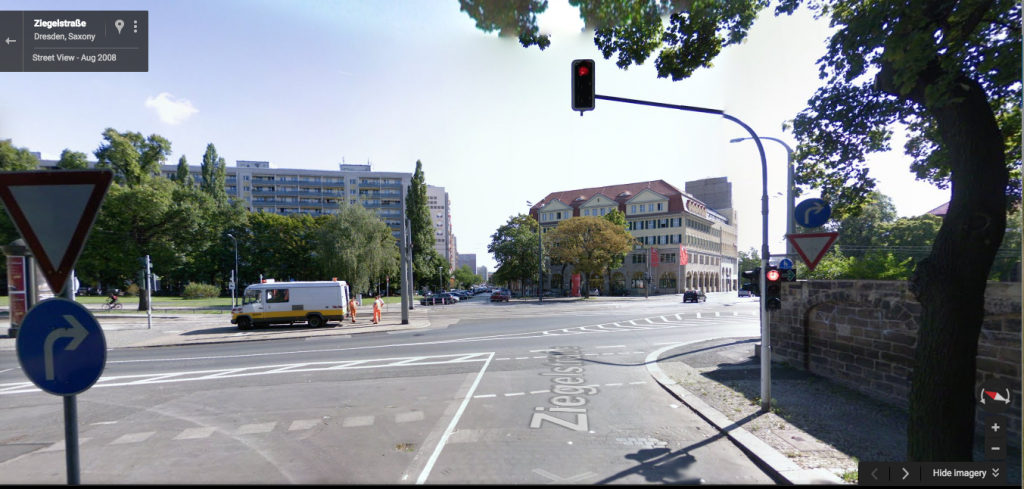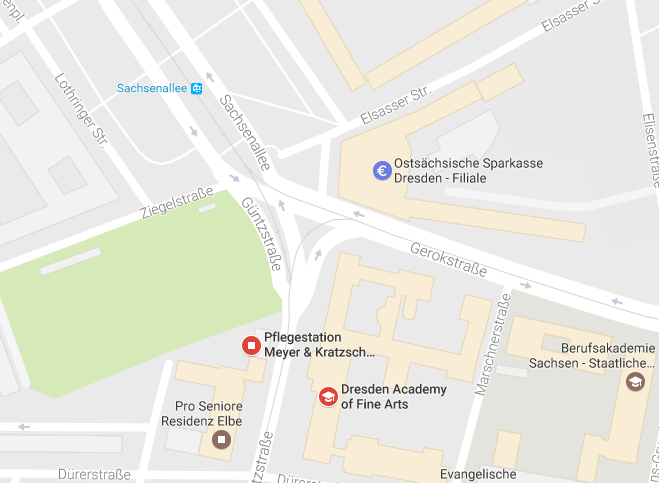The Red Light With a Very Long Wait


The intersection pictured above, via Google Maps (here), is from the German city of Dresden. The vehicle which captured that image is on a roadway called Ziegelstraße, facing an intersection where three more roadways meet: Gerokstraße, Güntzstraße, and (kind of) Sachsenallee. The names aren’t important, though. What’s important are all the traffic signals and signs — particularly that red light.
To see why, let’s zoom in on the street-level signal.

There are a few signs hanging out around that red light. Hanging off to the side, there’s a green arrow — that means that the driver may make a right turn even when the light is red, provided that the vehicle is first brought to a complete stop. Next to that is a standard yield sign, above which is a white arrow against a blue, circular field instructing drivers that they can only turn right while at the intersection. Here’s a screenshot of the intersection in Google Maps’ regular view, and you can see Ziegelstraße running along the north-ish edge of that park. It confirms that the only valid direction to go is to take a right onto Güntzustraße.

So, to recap:
- Assuming the light is red, you have to come to a complete stop, but once the way is clear, you can turn right.
- In fact, you can only turn right, given that circular blue sign;
- And for that matter, even if the light isn’t red, you have to give way to oncoming traffic (from the right), per the yield sign.
Which leads a driver to a weird conclusion — why would that light ever turn green? At best, the only impact would be that you wouldn’t have to come to that complete stop — you’d still have to yield, and you still wouldn’t be able to turn left or go straight. That’s not much of a reason for the light to change.
So, it doesn’t. As German news outlet The Local reported in 2015, the traffic light above has remained red since its installation in 1987 — nearly 30 years.
Yes, the light is almost entirely unnecessary — a stop sign would have the same effect, and stop signs are cheaper to maintain. But, as a spokesperson told The Local, the area’s traffic regulations don’t seem to care. The rules of the road are clear, per the spokesperson: “Stop signs do not correspond to traffic light systems and do not fulfill the same set of regulations.” In other words, because the other roads in the intersection need traffic lights, so does the one pictured above. That kind of makes sense, in theory at least, but in practice, it leads to the absurd result of a traffic signal that never turns green.
And an expensive one, too. The evergreen never-green (sorry, couldn’t resist) costs approximately €5,500/year to power and maintain, including light bulb changes. And that includes another level of bureaucratic inefficiency: according to German-language publication Berliner Zeitung (via Google Translate, with some clean up), “the city of Dresden also replaces the yellow and the green bulbs regularly,” even though they’re never used.
Bonus fact: Stop lights and stop signs work nearly the same way wherever you are, with one exception: Idaho But only if you’re on a bicycle. Cyclists can treat red lights as stop signs — they’re allowed to continue on, if clear, after coming to a complete stop; and similarly, they’re allowed to treat stop signs as yield signs. This rule, called an “Idaho stop,” hasn’t been adopted elsewhere (so don’t try it!) and it’s unclear whether it makes the roads more or less safe for cyclists and motorists alike.
From the Archives: Green Light, Red Light: The traffic light that’s out of order, but is in perfect working condition otherwise.
Related: A traffic light. It turns green.
